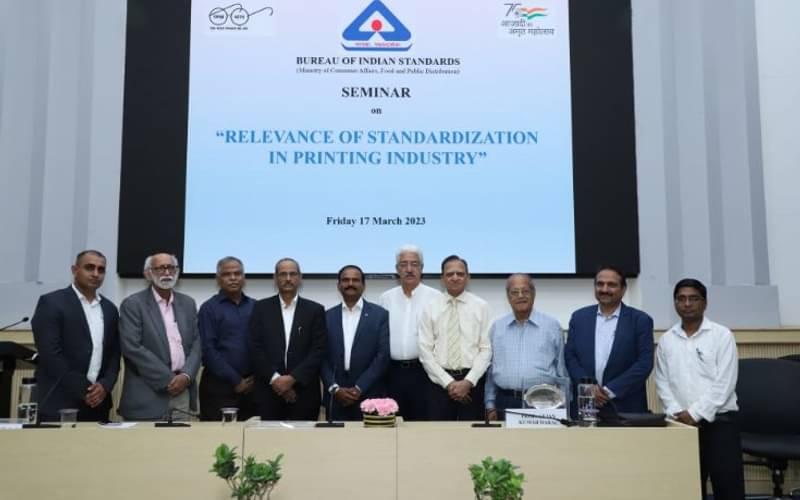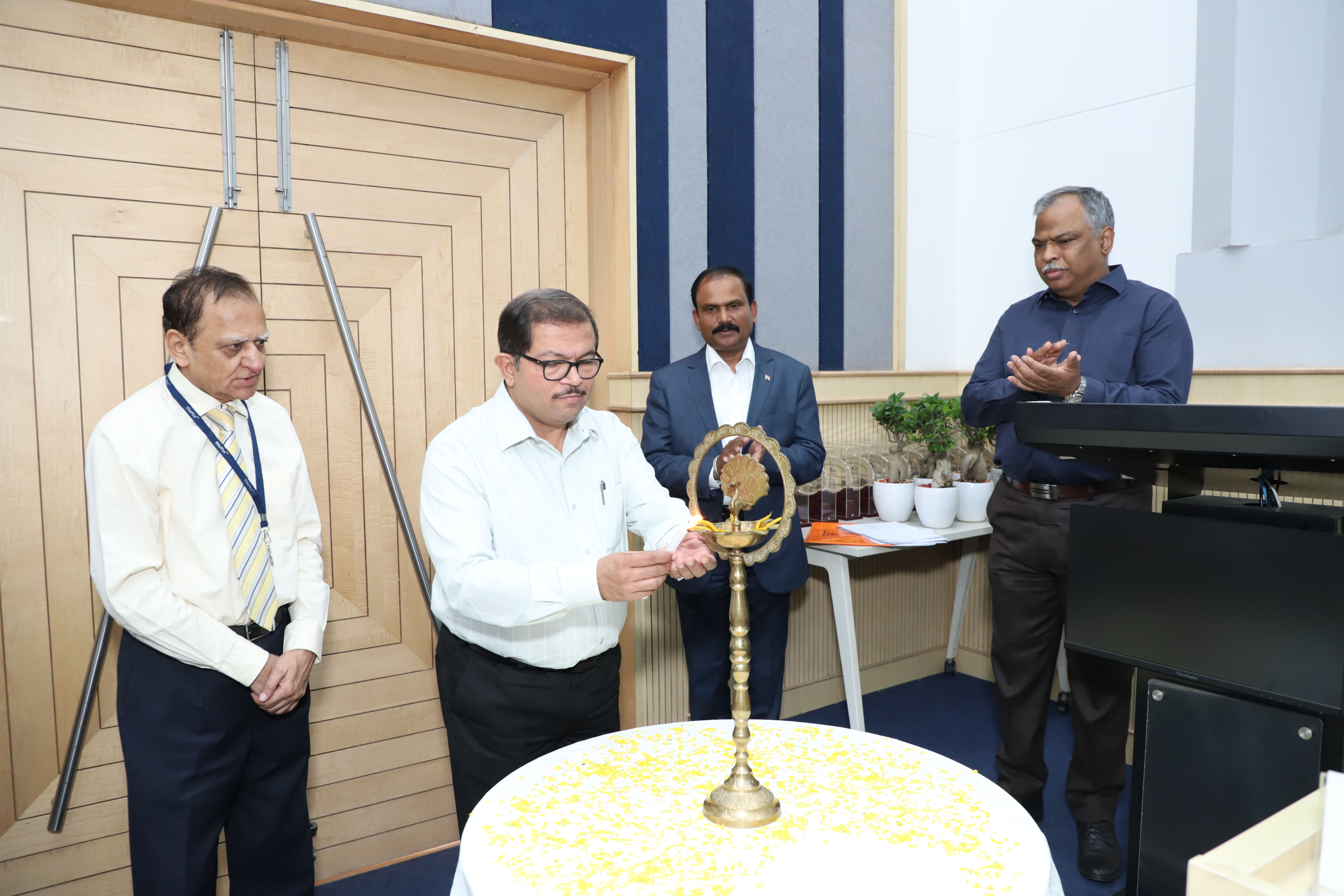Delhi hosts print standards gathering
The Management and Systems Development Council (MSD), Bureau of Indian Standards (BIS), Ministry of Consumer Affairs, Food & Public Distribution, Government of India organised a one-day seminar on the Relevance of Standardisation in the Printing Industry at the Manak Bhavan in March. More than 80 delegates from various organisations; including DRDO, Government of India press, universities, DPA, IPAMA, print CEOs from north India, and research scholars attended the seminar.
03 Apr 2023 | By Charmiane Alexander
AS Bhatnagar, scientist-F and head (MSD), stressed upon the available Indian Standards (IS) and International Standards (ISO) for the printing industry under MSD 6, BIS. He underscored the importance of adopting standards.
Dr Anjan Kumar Baral, chairman, MSD 6, during his keynote address, said, "In print, we trust". He pointed out how in the 15th century, an innovation enabled people to share knowledge more quickly and widely. Since then, human civilisation has never looked back." Baral added, "Printing made it possible to put information on paper quickly and cheaply, leading to an explosion in the distribution of books, pamphlets, pictures, and newspapers. Printing accelerated the spread of knowledge and the dissemination of ideas." Baral said, "Despite the technological advancements which allow us wireless access to the Internet from pocket-size devices, the special attributes of print media still render them an important source of information."
Later, Rajiv Sharma, scientist F&DDG, in his inaugural address stressed upon how standards are guidelines, processes and procedural instructions for production of printed products with repeatable and consistent quality that are recognised in the graphic arts industry and particularly in printing. Sharma said, "Yet, standards also create production stability within a company due to clearly structured workflows. Successful standardisation brings cost reductions and time saving in daily production and improves quality with fewer customer complaints.
The technical session started with an introduction of Ashish V Urewar, Scientist C (MSD), BIS. He shared his thoughts about the Overview of BIS, focussing on history, functions, role, importance, facilities and services provided by BIS to the Indian printers due to the Bureau of Indian Standards (BIS) Act 1986 plus the statutory status to BIS on 1 April 1987. He pointed out how the BIS Act 2016 enforced on 12 October 2017 makes BIS the National Standards Body of India. He intimated the scope of Publication and Graphic Technology Sectional Committee MSD 6 and the standards published under this sectional committee.
Prashant Atre, managing director Toyo Arets India, shared a presentation on, The Importance of Print in a Disruptive Digital World, with a special emphasis on current status of printing industry and how the printing industry is feeling the force of the digital age? He indicated; consumers, brand owners and mother earth as the three stake-holders for the print business set-up. He analysed the role of the three stake-holders and went on to explain how the introduction of colour television initiated the process of colour printing business.
Atre's presentation focussed upon offset printing opportunities along with innovation through UV printing and its applications and benefits. He discussed in detail about drying techniques of UV printing inks and how different substrates including; PP, PET, MetPet, metalised papers, etc. can be printed easily and effectively with UV inks. His presentation had a special emphasis on the sustainability aspects of UV inks, which focussed on Is UV safe?
This was followed by a detailed presentation by Naresh Khanna, the editor of Indian Printer and Publisher as well as Packaging South Asia and IppStar,, whose topic was, "Why Indian printers don’t follow standardisation and obtain certifications". He pointed out that, from manuscript to formatted presentation or print (mass replication) is a homogenisation and standardisation process. Print businesses are aware of standards.
Khanna shared 30,000 presses calibrate, standardise and own colour management software and hardware. But Khanna pointed out that 3,000 presses follow best practices and standardisation techniques such as testing of paper and inks, lighting, use of control strips and spectrophotometers. He said 600 presses have standardisation and follow best practices while 400 presses have formally standardised and have certified at least one press for one year. Khanna pointed out that of the hundred presses with standards at least fifty Indian newspaper plants have successfully become members of the Wan-Ifra Colour Quality club.
Kiran Prayagi, consultant and educationist, discussed quality and productivity through standardisation. He highlighted the importance of multiple stakeholders involved in process standardisation in the printing industry, various elements of total quality management; technical standards, training, documentation and ISO/BIS standards, 5S, Six Sigma and zero defects.
He pointed out the various printing processes and the workflow process that needs to be taken into account for a print press. He talked about print applications with special emphasis on packaging, speciality and security segments. He discussed the supportive structure; equipment and materials for a standardisation program. Prayagi stressed upon the company-level, industry-level, national-level and international standards and their importance for the printing industry. He discussed the various quality control tools and the potential benefits of training for enhanced quality which could optimise productivity.
Ishant Kalkal, head, customer support RSG Solutions gave a presentation on Colour Management and Calibration of Offset Machines. He focussed on the various steps involved in it along with the benefits of calibrating an offset machine for higher press output. He enumerated the various steps that need to be followed while calibrating the offset press and their possible effects on press productivity. Kalkal focussed on the relevance of colour management and how it affects the consistency and final print quality. He demonstrated various options available in sheetfed offset press calibrations.
Mukt Nath Pandey, the director of Avantika Printers shared his thoughts about the future of printed books which he said was buoyant. Pandey who had visited the Hunkeler Innovation Day said, there were several launches and product enhancements, and first showings held at the show from the likes of Canon, Ricoh, HP, and Kodak.
Two trends Pandey spoke about were: the biggest leaps forward in technology since 2019 in the press drying systems that are helping to facilitate high quality at very high speed, and the increased ability for continuous-feed inkjet presses to successfully run a much wider variety of substrates, including offset-coated stocks. Pandey also pointed out how inkjet treated media has also come down in price – still higher than offset-coated but closer than it was four years ago.
Pandey pointed out that the other big topic of conversation – with the show being held under the motto ‘Next Level Automation’ – was the way in which automation, including workflow, integrated high-speed finishing, robotics, handling systems, and the general reduction of touchpoints, has become more crucial than ever before since the pandemic.
Pandey said there were important lessons for someone like him who manufactures books. He said, "The book is like a spoon or scissors or hammer or shoe laces or a wheel! Once invented, it cannot be improved! Yes, minor modifications and tweaks (for example, reducing paper wastage from offbeat sizes) are possible." Pandey culminated his session with Indian book consumption data.
After Pandey, NS Manku, chairman, Joy D-Zign Engineers focussed on the relevance and importance of post-press aspects for a print shop, in today’s marketplace. He stressed upon the basics and simple steps, and how one can produce high quality print-finishing with value-added services. Manku pointed to recent trends in intelligent finishing systems which collates, jogs, stitches, folds and trims and handles sheets.
Dr. Anjan Kumar Baral, Chairman, MSD 6, who was moderator for the technical session. He said, the seminar underscored the importance of key standards being used on a daily basis by printers and their customers to improve process efficiency and control costs.




